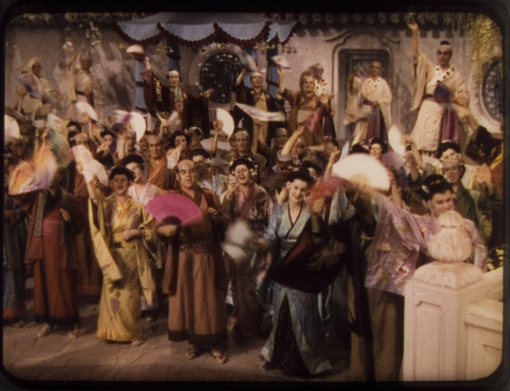Colour Films in Britain
Colour Films in Britain: The Negotiation of Innovation, 1900-55 By Sarah Street, with a Technical Appendix by Simon Brown (BFI/Palgrave Macmillan, 26 October 2012), 320 pages. ISBN: 978-1844573134 (hardback), £60; ISBN: 978-1844573127 (paperback), £18.99
 About the Author: Sarah Street is Professor of Film, Foundation Chair of Drama and Head of Subject, Drama: Theatre, Film, Television at the Universoity of Bristol. Her book publications include Cinema and State: The Film Industry and the British Government (co-authored with Margaret Dickinson, British Film Institute, 1985); British National Cinema (Routledge, 1997; 2nd edition 2009); Costume and Cinema (Wallflower, 2001); British Cinema in Documents (Routledge, 2000); European Cinema (Palgrave/Macmillan, co-edited with Jill Forbes, 2000); Moving Performance: British Stage and Screen (Flicks Books, co-edited with Linda Fitzsimmons, 2000); Transatlantic Crossings: British Feature Films in the USA (Continuum, 2002); The Titanic in Myth and Memory (I.B. Tauris, co-edited with Tim Bergfelder, 2004); Black Narcissus (I.B. Tauris, 2005), Queer Screen: The Queer Reader (Routledge, co-edited with Jackie Stacey, 2007) and Film Architecture and the Transnational Imagination: Set Design in 1930s European Cinema (Amsterdam University Press, co-authored with Tim Bergfelder and Sue Harris, 2007).
About the Author: Sarah Street is Professor of Film, Foundation Chair of Drama and Head of Subject, Drama: Theatre, Film, Television at the Universoity of Bristol. Her book publications include Cinema and State: The Film Industry and the British Government (co-authored with Margaret Dickinson, British Film Institute, 1985); British National Cinema (Routledge, 1997; 2nd edition 2009); Costume and Cinema (Wallflower, 2001); British Cinema in Documents (Routledge, 2000); European Cinema (Palgrave/Macmillan, co-edited with Jill Forbes, 2000); Moving Performance: British Stage and Screen (Flicks Books, co-edited with Linda Fitzsimmons, 2000); Transatlantic Crossings: British Feature Films in the USA (Continuum, 2002); The Titanic in Myth and Memory (I.B. Tauris, co-edited with Tim Bergfelder, 2004); Black Narcissus (I.B. Tauris, 2005), Queer Screen: The Queer Reader (Routledge, co-edited with Jackie Stacey, 2007) and Film Architecture and the Transnational Imagination: Set Design in 1930s European Cinema (Amsterdam University Press, co-authored with Tim Bergfelder and Sue Harris, 2007).
E-mail: sarah.street@bristol.ac.uk
Colour Films in Britain: The Negotiation of Innovation, 1900-55 is the first study to trace the history of colour films, their styles and technologies in Britain during a half-century when colour films were far from the norm. The book demonstrates how many British inventors and filmmakers were captivated by the possibilities created by colour, exploiting different processes and producing films that demonstrated remarkable experimentation and quality. Unlike the coming of sound, colour did not revolutionise the film industry overnight, and charting the British experience of colour offers fascinating insights into the complex network of issues that accompany the introduction of new technologies. Colour was a controversial topic, greeted by some as an exciting development with scope for developing a uniquely British aesthetic, while others feared its impact on audiences accustomed to seeing black-and-white films that were frequently praised as being superior. Colour Films in Britain shows, for example, how Hollywood Technicolor was often critiqued as being garish and vulgar, whereas the British press and filmmakers promoted a tastefully restrained national style. This was in many ways a rhetorical position aimed at fostering a stronger foothold in a British domestic market dominated by Hollywood. Indeed, this nationalist rhetoric in response to international exchange was one of the ‘negotiations’ that British colour cinema navigated. Street argues that the unique contribution of the many British technicians and directors was achieved through a complex process of negotiating their way through economic, technical and aesthetic challenges posed by colour in the first half of the twentieth century.
British technicians were responsible for producing some remarkable colour films, often enriching approaches to colour developed by dominant companies such as Technicolor, as well as creating their own innovative methods and styles which continue to influence cinema today. The book demonstrates how technologies such as Kinemacolor, Prizmacolor, Dufaycolor and Technicolor were devised and received in the light of British colour tastes and iconograpic traditions. Twelve chapters examine a wide range of colour technologies, charting their development and analyzing key examples from popular cinema, documentaries and avant-garde films. Significant genres are highlighted, such as melodrama, fantasy and empire, that provided scope for adventurous colour designs during key periods such as the Second World War, when short and documentary films led the way in colour innovation.
 Learning on Screen
Learning on Screen

